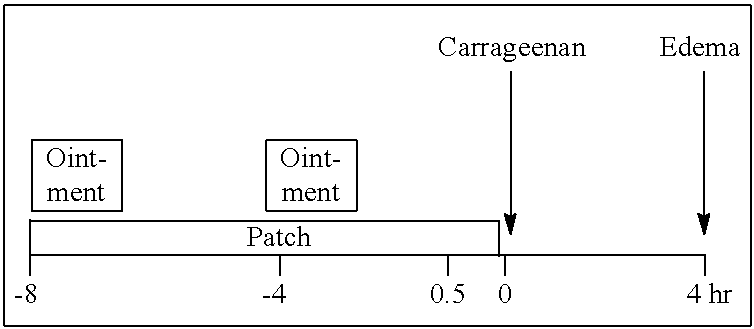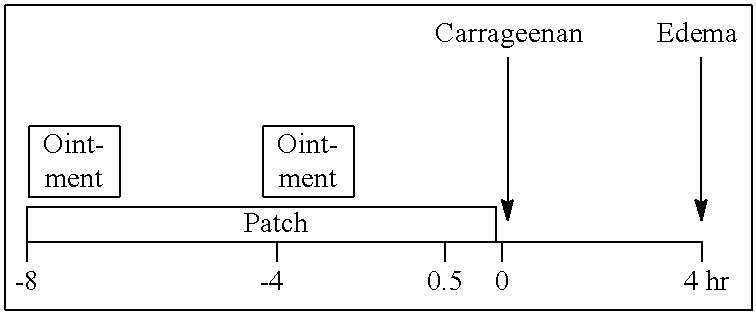Transdermal drug delivery system and method of using the same
a drug delivery and transdermal technology, applied in the direction of drug compositions, biocide, bandages, etc., can solve the problems of skin atrophy, depigmentation of the eyelid at the injection site, formation of subcutaneous white (steroid) deposits in the treated area, etc., to achieve effective and safer treatment
- Summary
- Abstract
- Description
- Claims
- Application Information
AI Technical Summary
Benefits of technology
Problems solved by technology
Method used
Image
Examples
formulation example 1
[0076]An SIS (styrene-isoprene-styrene)-based pressure sensitive adhesive was obtained by blending 100 parts by weight of a hydrogenated rosin ester resin (trade name “Pinecrystal KE311”) as a tackifier with 100 parts by weight of a styrene-isoprene-styrene block copolymer (trade name “Quintac 3520”). 99.0 w / w % of the SIS-based pressure sensitive adhesive (Pinecrystal KE311 / Quintac 3520 ratio is 50% / 50% (w / w)) and 1.0 w / w % of clobetasol propionate were dissolved in toluene to obtain a coating fluid having a solid content of 50% by weight. This coating fluid was coated on release paper so as to give a dry coat thickness of 40 μm. After drying, a support (polyester film having a thickness of 12 μm) was laminated to provide a patch preparation.
formulation example 2
[0077]0.005 g of a crosslinking agent (chelate-type crosslinking agent; trade name “NISSETSU CK-401”), and 0.05 g of clobetasol were added to 12.363 g (Solids: 4.945 g) of an acrylic pressure sensitive adhesive [trade name “NISSETSU PE-300”; alkyl (meth)acrylate-vinyl acetate copolymer; pressure sensitive adhesive solution having a solid content of 40% by weight (ethyl acetate / toluene mixed solvent)] to prepare a coating fluid having a concentration of 57.3% by weight. This coating fluid was coated on release paper so as to give a dry coat thickness of 80 μm. After drying, a support (polyester film having a thickness of 12 μm) was laminated to provide a patch preparation.
formulation example 3
[0078]A pressure-sensitive adhesive solution (coating fluid) having a solid content of 40% by weight was obtained by dissolving 40.5 g of a styrene-isoprene-styrene block copolymer (trade name “SIS5000”) as a rubbery elastic substance, 40.5 g of a terpene resin (trade name “YS Resin 115ON”) as a tackifier and 10 g of clobetasol propionate in 150 g of toluene. This coating fluid was coated on release paper so as to give a dry coat thickness of 40 μm. After drying, a support (polyester film having a thickness of 12 μm) was laminated to provide a patch preparation.
PUM
| Property | Measurement | Unit |
|---|---|---|
| diameter | aaaaa | aaaaa |
| thickness | aaaaa | aaaaa |
| thickness | aaaaa | aaaaa |
Abstract
Description
Claims
Application Information
 Login to View More
Login to View More - R&D
- Intellectual Property
- Life Sciences
- Materials
- Tech Scout
- Unparalleled Data Quality
- Higher Quality Content
- 60% Fewer Hallucinations
Browse by: Latest US Patents, China's latest patents, Technical Efficacy Thesaurus, Application Domain, Technology Topic, Popular Technical Reports.
© 2025 PatSnap. All rights reserved.Legal|Privacy policy|Modern Slavery Act Transparency Statement|Sitemap|About US| Contact US: help@patsnap.com



